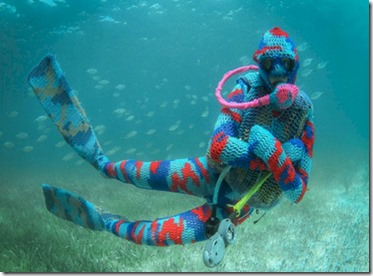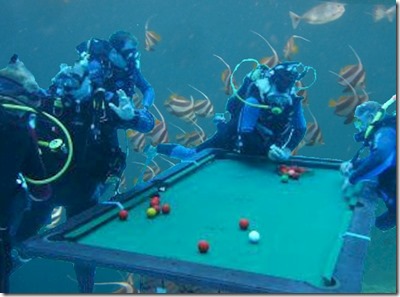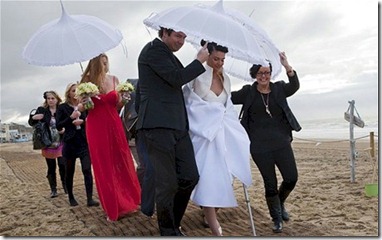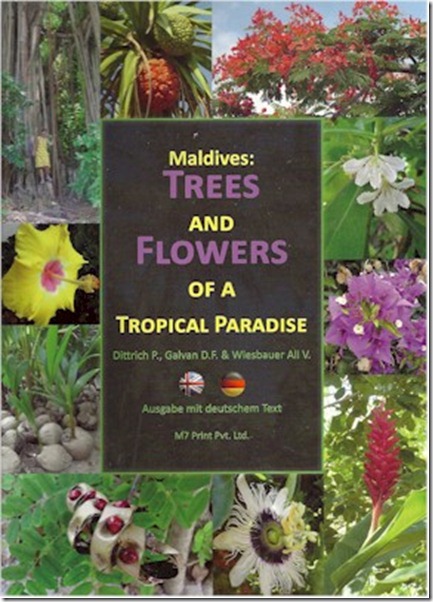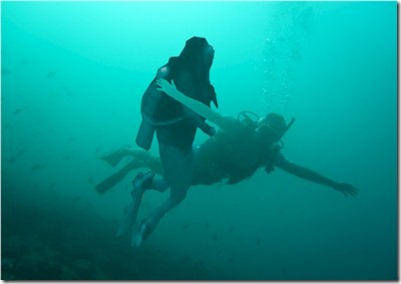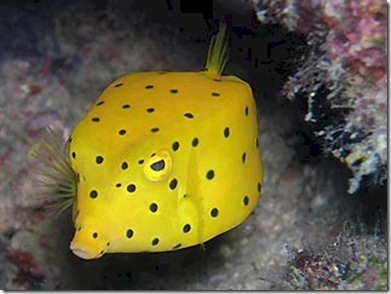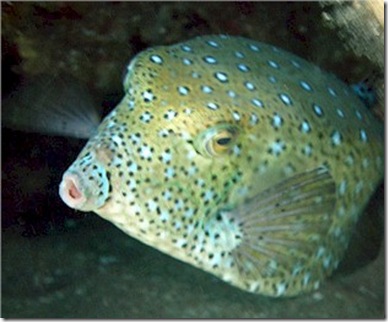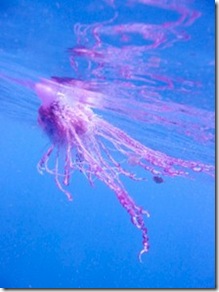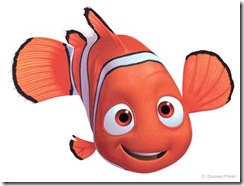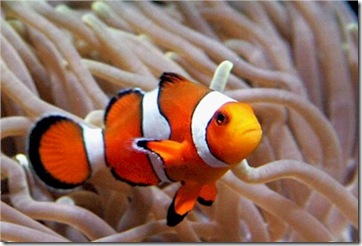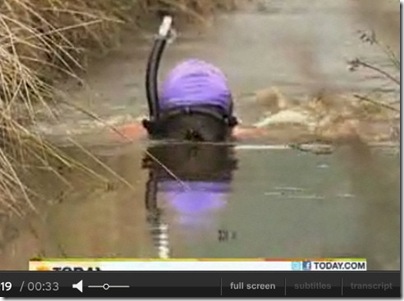From nutty to knitty (and maybe not much difference between the two even). The less known Haa Pril Fulshi resort has introduced new developed crochet dive suits. This new fashion must-have for the trendy diver combines colourful whimsy with soft natural fabrics instead of the awkward conventional neoprene gear. Unfortunately, the suits can only be worn once due to shrinking. Available on Etsy.com.
Best of the Maldives: Underwater Pool – Maaprolfulshi
Underwater marvels are some of the signature features of the Maldives paradise. And with the flood of underwater restaurants, bedrooms, night clubs, function rooms, spas, cabinet meetings, golf courses, Christmas trees, art, and even scuba massage, innovative new offerings are demanding more and more creativity. So many are there that I have introduced an ‘underwater’ tag to the blog today (not the natural features and creatures, but the man-made stuff).
The lesser known resort of Maaprolfulshi has tossed its hat into this watery ring with its newly introduced underwater pool. No, not a ‘pool’ that is underwater. That would be just silly! But an underwater pool table. It also accommodates games of billiards and snooker (see above).
Break!
Flat Empty Water
Red Nose Day today. No, not a rash of under-applied zinc-oxide, but the UK’s day for goofing around for charity. I love the XKCD cartoon and it’s ‘deeper’ message about how much richness is below the surface. An apt metaphor for the always adventuresome and somewhat mysterious paradise of the Maldivies.
In the spirit of the day, I will donate a £1 for every comment to today’s post that provides something missing from the cartoon above if it were a Maldivian island.
Beach Wedding Fail
Is this some kind of April Fools Joke? Or maybe just a joke by some fools in April?
More evidence that the British Isles are twinned with the Maldives in Opposite Land. At first, it is hard to believe that a country with 11,073 miles of coastline (compared to the 36,122 miles of coastline in the Maldives) has never had a beach wedding. But then again, as I write this post sitting by my cozy fire in near May with a freezing, wet gale blowing outside…maybe not. Wedding recessional complements of Keyboard Cat methinks…
As the olde English rhyme says “April showers bring May flowers”…but the UK might just want to keep the ‘wedding showers’ contained to exchanging presents over tea in the front room and leave the beach weddings to the Maldives.
Maldives QI, Part 4
Having recently had a beer with a writer from QI and keeping up the humour, I thought it time for the next installment of ‘Maldive QI’…
- Q: Where do you find the ‘Maldives Coconut’?
- A: Maldives?
- Buzzzz!
The ‘Maldives Coconut’ is very much a part of the Maldives history, but curiously not part of the Maldives itself. Der Spiegel recently did a piece on the intriguing nut…
“The captain surely imagined it all a little differently. The French adventurer Francois Pyrard intended on sailing to India in 1602. But when his ship Corbin gave out on the open seas, he had to seek refuge in the Maldives. Unfortunately, the king there wouldn’t let the shipwrecked party leave for five years. When Pyrard and his crew were finally able to flee, they took the tale of the strange fruit with them back to Europe. It had been found frequently on the beaches of the islands. It wasn’t just that they were gigantic, the fruit’s shape was also reminiscent of a woman’s pelvic region. The king demanded that these alluring finds be delivered directly to him, and threatened that those who didn’t comply would lose a hand, or even be put to death. What Pyrard saw was the nut of the Coco de Mer palm, one of the rarest palm trees on the planet, also known as the Lodoicea maldivica. It is three to four times as large as an average coconut. They are also heavier than anything comparable that biologists can find, weighing up to 20 kilograms (44 pounds).”
It actually grows in the Seychelles, but makes its way to its namesake islands (“maldivica”) floating on the Indian Ocean waters which may account for its colloquial name, ‘Coco de Mer’. Der Spiegel describes this intriguing species in some detail on the occasion of the Botanical Garden in Berlin succeeding in germinating it. Despite its rather fertility-suggstive appearance, it is actually dubbed the ‘Panda of the Plant World’ for its difficulty in growing.
I researched the beguiling nut talking to Verena Wiesbauer Ali who not only helped with the previous QI pieces, but also co-authored the first definitive picture guide to the flora of the Maldives ‘Maldives: Trees and Flowers of a Tropical Pardise’. There are dozens of various guide books to the underwater delights of the islands, but this is the first that provides a comprehensive catalogue with dazzling colour photos for land lubbers. You can get a copy by writing to the co-authour Peter Dittrich (25 Euros) to find out what coconut palms and every other type of colourful and curious tree and plants that do grow there.
Best of the Maldives: Underwater Massage – Kurumba
If a sliver of sand is not close enough to aquatic blissful relaxation, then Kurumba’s underwater scuba massage treatment (launched today!) should literally soak away the stress. Aprille Phoulle of the Veli Spa explained…
“Many of our divers get a whole range of muscle soreness and tensions from having heavy tanks on their backs. We figured why not provide the soothing treatment they need in the environment they love. Sure, more and more resorts are offering underwater spas and restaurants, but we are the first to go truly underwater with our services. At our latest underwater management meeting (modelled after the government’s cabinet meeting) decided to literally take to plunge. Customers have the choice of a table massage (anchored to the lagoon floor) or a ‘free floating’ treatment. The latter combines the benefit of a ‘flotation tank’ as the clients are set at neutral buoyancy. Due to the warm tropical waters of the Maldives, it is quite comfortable diving in just a t-shirt and trunks making it easy for the PADI-certified therapist to work those sore muscles (not mussels). We use only the finest Ayurveda, eco-friendly fish oils like ‘Tranquility Tuna’ and ‘Box Fish Bliss.’ The treatment also naturally includes something that has become a popular pedicure treatment in Europe, fish depilation, as wrasses delight in gently nibbling at the dead skin especially the crispy, sunburnt type. A tank of air is just right for a half-hour session.”
The Euro-Diver dive centre has also collaborated with the Veli Spa on a range of other treatments designed for the diver set such as the “Nitrox Detox” and the “Scuba Scrub”. They are also working with PADI to develop a range of new specialty skills that can be combined with ‘Underwater Massage’ such as ‘Compressed Air Aromartherapy’ for a ‘Dive Therapist’ certification.
Maldives QI, Part 3
Question: What is this a picture of?
Answer: A Yellow Box Fish.
[Soundeffect]: Ding! Correct. You get no points because that was so easy (it is yellow and it looks like a box). Now, what is the fish below?…
Answer: A grey/green boxfish?
[Soundeffect]: Buzzzz! Wrong. This is also a ‘Yellow Boxfish’ or Ostracion cubicus. The Yellow Boxfish, which you can see quite prevalently in the Maldives, loses its bright yellow colour as it matures.
Thanks Chase (unofficial president of the Boxfish fan club).
Maldives QI, Part 2
Question: What is this a picture of?
Answer: A Jelly Fish.
[Soundeffect]: Buzzzz! Wrong. This is a ‘Portugese Man of War’ which is not actually a ‘jelly fish’ but a “siphonophore. Siphonophores “differ from jellyfish in that they are not actually a single creature, but a colonial organism made up of many minute individuals called zooids. Each of these zooids is highly-specialized and, although structurally similar to other solitary animals, are attached to each other and physiologically integrated to the extent that they are incapable of independent survival.” In this respect, Portugese Man Of Wars, also know as just ‘Man of Wars’ or ‘Blue Bottles’, are more like coral polyps.
As it turns out, this fact was so obscure that it escaped the Ceremonial Master himself in the first series of QI. Stephen Fry referred to a ‘jellyfish’ as the ‘right class of animal’ as a ‘Portugese Man-of-War’. In reality, Man of Wars are not even the same of the same Order as jellyfish. They are in the order Hydrozoa, while jelly fish are in the order Scyphozoa…
Bill: Forget the buzzers. Off the buzzers now. I would hazard a guess and say the, erm, the Portuguese Man-of-War.
Stephen: Oh, now, do you know, I’m gonna give you five points, ’cause you’re so much in the right class of animal.
Bill: Ah! See?
Stephen: It is a jellyfish.
Bill: A jellyfish.
Stephen: Yeah. It is a jellyfish.
Just one of the many fascinating facts we learned about Maldive ocean life during the talk by Marine Biologist Verena Wiesbauer Ali put on by Kurumba.
Maldives QI, Part 1
In honour of Stephen Fry’s brilliant QI (short for ‘Quite Interesting’) TV comedy quiz show returning to BBC this weekend, we feature a couple of Maldives QI questions of our own…
Question: What common, colourful fish in the Maldives is this a picture of?
Answer #1: A ‘Nemo’ Fish.?
[Sound effect]: Buzzzz! Wrong. The character ‘Nemo’ in Disney’s film ‘Finding Nemo’ had three white stripes as a opposed to the single one shown above.
Answer #2: A Clown Fish.
[Soundeffect]: Buzzzz! Wrong. You are close in that the term ‘clown fish’ is often applied to all members of the family of ‘Anemonefish’, but not all Anemonefish are really clown fish including this specimen.
Anemonefish are from the subfamily Amphiprioninae in the family Pomacentridae and only one specific species of Anemonefish, Amphiprion ocellaris, is actually designated the ‘Clown Anemonefish’. The fish shown at top is really a ‘Amphiprion nigripes’, also known as a ‘Maldive anemonefish’. With its cousin ‘Amphiprion clarkii’ (also known as ‘Clark’s anemonefish’ or the ‘Yellowtail clownfish’), they are the two species of Anemonefish (out of 27 that exist worldwide) found in the Maldive waters.
As it happens, a number of Anemonfish have also been dubbed ‘Clownfish’ in their informal names such as Amphiprion perideraion (Pink skunk clownfish) and the Amphiprion melanopus (Fire or Cinnamon clownfish) as well as obviously ‘Clark’s which I said is known as the ‘Yellowtail Clownfish’. But not this species here. Even Wikipedia describes the terms ‘Clownfish’ and ‘Anemonefish’ as interchangeable, but now you know the real distinctions.
Thanks to Sarah Kompatscher, Marine Biologist at Anantara, and Verena Wiesbauer Ali, Marine Biologist for Kurumba.
Proper ‘Nemo’ or ‘Clown Anemonefish’
World’s Worst Snorkelling
If the Maldives is the ‘Best Snorkelling in the World’, then where would be the worst?
Hint – Think about the opposite of sunny, tropical weather. Also, think desperate nut cases.
The opening line to this MSNBC Today report says it all – “Wet and windy weather in Wales makes perfect conditions for…snorkelling.”

